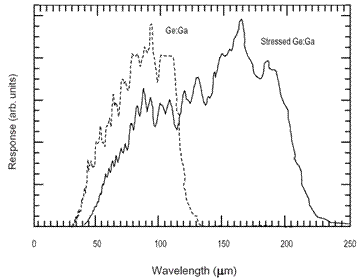Photoconductor Array Camera and Spectrometer
Figure: Relative Response of Ge:Ga Detectors. Relative
response of stressed (solid line) and unstressed (dashed line)
Ge:Ga detectors.
The PACS instrument [1]. However, these detectors have photoconductive thresholds at 130µ (unstressed) and 210µ (stressed), respectively, and for observations at longer wavelength, Herschel uses either heterodyne (HIFI) or bolometer (PACS) detectors. Figure: Relative Response of Ge:Ga Detectors shows the relative response of these detectors as a function of wavelength. In its photometry mode PACS will perform photometry (λ/Δλ~2) simultaneously in the two bands, with a mesh filter selected choice (60-90µ/ 90--130µ) available on the unstressed shorter wavelength array. This two-color system is designed for the study of broad emission features of external galaxies. In its spectrometer mode PACS has a resolution of ~1500. This is accomplished with a diffraction grating in a Littrow configuration and a dichroic beam splitter to separate diffraction orders. In this configuration, multiplex spatial imaging is retained by the use of a 5 x 5 pixel detector array.
PACS complements HIFI in two important aspects and is a good illustration of the technology trade-offs that are still necessary in the THz. First, because it does not require local oscillator power for mixers, the difficulties of producing power at high frequency are eliminated. Secondly, it is much easier to build arrays of photo-detectors than it is to build focal plane arrays of heterodyne mixers. Thus, for astrophysical projects which require large scale photometric surveys, the arrays of PACS provide spatial multiplexing and a large gain in the overall photometric efficiency for the system.
References
- The Photoconductive Array Camera and Spectrometer (PACS) for FIRST UV, Optical, and IR Space Telescopes and Instruments 4013, 221-232 (2000). Google Scholar
- FIRST-PACS: design and performance of the sensor engineering models UV, Optical, and IR Space Telescopes and Instruments 4013, 233-243 (2000). Google Scholar
- Stressed Ge-Ga Photoconductor with a Compact and Stable Stressing Assembly Infrared Phys. 29, 255-259 (1989). Google Scholar
- Stressed and Unstressed Ge-Ga Detector Arrays for Airborne Astronomy Int. J. Infrared Millimeter Waves 13, 1689-1707 (1992). Google Scholar